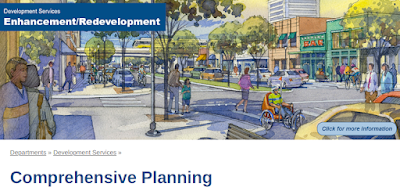Recently, I've been meddling in the City of Richardson's efforts to update its Comprehensive Plan. To decide who is off the rails—them, me, or maybe neither—I've decided I need to back up (to first principles), or pull up (for a birds-eye view), to understand just what the City thinks is included in this effort.
I went back to the Request for Qualifications for consultant services for the Richardson Comprehensive Plan (RFQ NO. 2023-01 issued September 1, 2022. I wanted to see what the City was telling the consultants it hired to facilitate this effort. Here are the introductory paragraphs.
The City of Richardson, Texas is seeking qualified candidates to respond to this Request for Qualifications (RFQ) for professional services to conduct an update to the City’s Comprehensive Plan.
With only 3.3% of undeveloped land remaining, the City is largely built out and thus the focus of the Comprehensive Plan update will largely be related to infill, redevelopment, and neighborhood revitalization projects to maximize use of existing infrastructure and community assets. The Comprehensive Plan update should provide clear land use, planning and economic development strategy/direction for the next 20 years in an attractive and user-friendly format.
Source: City of Richardson (RFQ 2023-01).
OK, that maybe explains why at the July 31st City Council meeting reviewing efforts so far, the consultants jumped immediately from reviewing public input to a recommendation for which areas of the city should get further study as "reinvestment areas." According to the City's directive in this RFQ, that's pretty much the "focus" of the update process. So jumping right into that might just be the consultants' following directions.
Even though it may not be the "focus," in its services, tasks, and deliverables the RFQ also includes "Integrate current and upcoming planning efforts into the Comprehensive Plan." Those other planning efforts include, but are not limited to, the "Parks, Recreation and Open Space Master Plan", "Active Transportation Plan", and an "Economic Development Strategic Plan". Those planning efforts will be done (or have already been done) by different teams and at different times, but the updated Comprehensive Plan will include their outputs and reference them. So don't be surprised if these consultants don't spend much time on, for example, bike lanes. Someone else already covered that.
All in all, it seems, to this untrained eye, to be a good and comprehensive RFQ. It contains not only that birds-eye view of the process that I was looking for, but also a surprisingly detailed list of services, tasks, and deliverables. Here is one detail that I and others have called out as wanting to see: "Analysis of the current supply and future demand for various types of land uses, including current housing types and new housing types based on existing and emerging trends, such as accessory dwelling units and workforce housing." Personally, if the public gets not just an analysis of housing demand, but recommendations for how the City of Richardson can achieve a greater supply of ADUs and workforce housing (hint, zoning changes, for one), I will be very pleased.
I recommend reading the entire RFQ. I also recommend that the City Council
adopt a scorecard for how well the update process is completing the
I also reviewed the City's Comprehensive Plan Update Introduction that was presented to the City Council on July 11, 2022. It reads like an executive summary of that RFQ. If you can't read both, I'd read the RFQ.
P.S. Like fingernails across a blackboard (do people today still know what that sounds like?), one sentence in this RFQ screeched in my ears. I've italicized it in case it doesn't sound discordant to you:
Even with all of these assets, Richardson is experiencing the typical challenges of many first-ring suburbs: an increasingly diverse population, infrastructure challenges, an aging housing stock, underperforming retail development, and aging and underutilized industrial properties.Source: City of Richardson (RFQ 2023-01).
I agree that aging housing, underperforming retail, and underutilized industrial properties are all challenges. But "an increasingly diverse population" is not. That's more of an asset than a challenge. That's all I want to say about that.
P.P.S. In the original draft of this post, I described myself as "kibitzing," a word I've used since childhood, where I learned it from watching my father's generation play Sheepshead. I changed it to "meddling" out of concern that the use of the Yiddish word "kibitz" by me, a non-Jewish person, might be considered unwelcome cultural appropriation. Is there anything to that? Does it matter that I think kibitzing is more accurate in this case than meddling?
Regardless, my meddling hardly ever bothers anyone. I'm used to being ignored. Maybe used to being unnoticed is a more accurate word choice. OK, that's the end of the language analysis for today.
"User-friendly guide,
Twenty years, a sweeping scope,
In haikus we dream."
—h/t ChatGPT


No comments:
Post a Comment